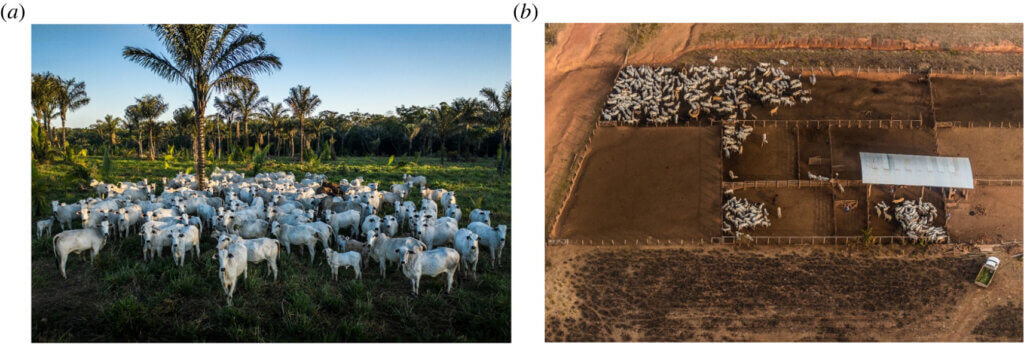It is often asserted that intensive livestock systems increase the risk of zoonotic diseases, and this argument is used to make the case for a switch to more extensive, lower yielding farming practices.
In November 2020, for example, in the wake of the COVID19 outbreak, the Soil Association described the pandemic in terms of a wake-up call from Mother Nature to return to more traditional farming practices. “It feels to me as if the coronavirus pandemic is nature giving humanity one last chance to stop, take stock and to set a new course,” said chief executive Helen Browning.
However, research by a team of ecologists and veterinary scientists at the Universities of Cambridge and Leeds has scrutinised the scientific basis for this general argument, and instead found the evidence to be much more mixed, and indeed that intensive livestock farming could in fact reduce the risk of future pandemics.

In a new paper, published in the journal Royal Society Open Science, we found that, contrary to the prevailing wisdom, moving away from intensive farming by switching to more extensive production systems, such as ‘free-range’, could actually increase pandemic risks.
This is partly because extensive farms require much more land to meet demand for meat, eggs and dairy, which would in turn drive habitat loss and disturb more wildlife, potentially including species that could host the next pandemic virus.
Most emerging infectious diseases (EIDs) are caused by zoonotic pathogens maintained in animal hosts which occasionally overcome barriers to spill over and cause pandemics in humans. The greatest number of zoonotic viruses of concern are found in domesticated animals (such as pigs and cattle), and in those wild animal species (particularly bats and primates) impacted by habitat loss.
Overall, the risks of EIDs are escalating, driven by rapidly increasing global demand for animal products (livestock biomass now vastly exceeds that of wild mammals and birds), and a corresponding expansion of land used for livestock and feed production which brings people, livestock and wild animals closer together.

Globally, we are now producing four times more meat than we did in the 1960s. Most of our meat, eggs and dairy come from intensive farms – e.g. 81% of chicken, 61% of pork and 86% of eggs.
Of course, one approach to reducing EID risks would be to dramatically reduce meat consumption, allowing for widespread restoration of natural habitats and increasing the health of wild populations, while also reducing the opportunities for transmission to livestock and people.

However, given long-term trends in per capita wealth and the strong correlation between income and consumption of livestock products, reducing livestock demand substantially is likely to be extremely challenging. In 2019, the World Economic Forum forecast that demand for meat will double before 2050 as the global population increases, becomes wealthier on average, and adopts food choices that are currently restricted to high-income countries.

The importance of production intensity in meeting future global food demands is critical, and can be illustrated by examining projections of future agricultural land use. For example, a recent study found that a business-as-usual scenario could require an additional 12.5 million km2 of farmed land between 2009 and 2050 – an area roughly the size of Brazil and India combined. This would most likely come at the expense of natural ecosystems. However, if instead ‘intensive’ livestock systems were used, the same study found that 31% less land than the business-as-usual scenario would be needed by 2050.
Whether intensive or extensive farms are riskier in terms of EIDs depends on the balance of risks between disease “spillover” (i.e. the first transmission from a wild animal) versus disease “takeoff” (i.e. the disease spreading rapidly and getting out of control).
Animals in intensive farms are kept closer together, meaning that if a disease does get in, then it is more likely to ‘takeoff’ and spread rapidly.
However, more extensive farming systems require much more land to produce the same amount of food. This means that a widespread switch to extensive farming could drive substantial habitat loss, and could increase the contact between people, livestock and stressed wildlife – posing a much greater risk of “spillover” from wildlife that might well host the next pandemic virus.
Worryingly, our research found that we simply lack the evidence to conclude which way of farming is least risky, and indeed there is evidence – perhaps counter-intuitively – that any move away from intensive farming might actually increase the risk of future pandemics.
With policy approaches such as the EU Farm to Fork Strategy moving towards more extensive farming systems and advocating a significant switch to organic farming, our study suggests that more evidence in terms of EID risks is needed before changing policies or incentivising a particular type of farming.
COVID19 has demonstrated the huge potential impact of zoonotic diseases, and this study highlights that more research is urgently needed to identify how we minimise the risks of another pandemic.
Harriet Bartlett is a researcher at the Departments of Zoology and Veterinary Medicine at the University of Cambridge. She is lead-author of the study ‘Understanding the relative risks of zoonosis emergence under contrasting approaches to meeting livestock product demand’, published in the Royal Society Open Science journal on Wednesday 22 June 2022. The paper is available open access here. Follow Harriet on Twitter @HarrietBartlett
A version of this article was posted at Science for Sustainable Agriculture and is used here with permission. Check out Science for Sustainable Agriculture on Twitter @SciSustAg































